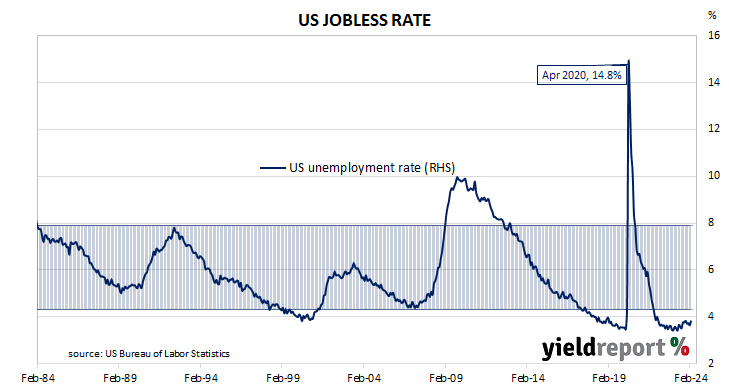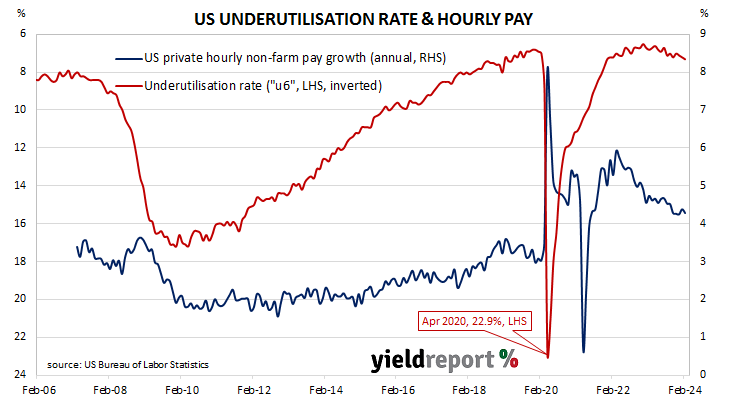Summary: US non-farm payrolls up 275,000 in February, above expectations; previous two months’ figures revised down by 167,000; ANZ: US labour market still healthy; jobless rate rises to 3.9%, participation rate unchanged at 62.5%; short-term US Treasury yields down a little, longer-term yields up slightly; expectations of Fed rate cuts in 2024 firm; employed-to-population ratio slips to 60.1%; underutilisation rate ticks up to 7.3%; annual hourly pay growth slows to 4.3%.
The US economy ceased producing jobs in net terms as infection controls began to be implemented in March 2020. The unemployment rate had been around 3.5% but that changed as job losses began to surge through March and April of 2020. The May 2020 non-farm employment report represented a turning point and subsequent months provided substantial employment gains which continued through into 2021, 2022 and 2023.
According to the US Bureau of Labor Statistics, the US economy created an additional 275,000 jobs in the non-farm sector in February. The increase was considerably higher than the 190,000 rise which had been generally expected and greater than the 329,000 jobs which had been added in January. Employment figures for December and January were revised down by a total of 167,000.
“The broad picture is that the labour market is still healthy, and the Fed will read this report as an affirmation of its patient stance,” said ANZ Head of Australian Economics Adam Boyton. “The market, however, saw it as a dovish report overall.”
The total number of unemployed increased by 334,000 to 6.458 million while the total number of people who were either employed or looking for work increased by 150,000 to 167.426 million. These changes led to the US unemployment rate rising from January’s figure of 3.7% to 3.9%. The participation rate remained unchanged at 62.5%.
US Treasury yields declined at the short end of the curve on the day while longer-term yields were steady or slightly higher. By the close of business, the 2-year yield had lost 2bps to 4.49%, the 10-year yield had returned to its starting point at 4.09% while the 30-year yield finished 1bp higher at 4.26%.
In terms of US Fed policy, expectations of a lower federal funds rate in the next 12 months firmed, with several cuts currently factored in. At the close of business, contracts implied the effective federal funds rate would average 5.325% in March, essentially in line with the current spot rate, 5.32% in April and 5.265% in May. However, September contracts implied a 4.85% rate, 48bps less than the current rate, while February 2025 contracts implied 4.235%, 109bps less than the current rate.
One figure which is indicative of the “spare capacity” of the US employment market is the employment-to-population ratio. This ratio is simply the number of people in work divided by the total US population. It hit a cyclical-low of 58.2 in October 2010 before slowly recovering to just above 61% in late-2019. February’s reading slipped from 60.2% to 60.1%, some way from the April 2000 peak reading of 64.7%.
Apart from the unemployment rate, another measure of tightness in the labour market is the underutilisation rate and the latest reading of it registered 7.3%, up from 7.2% in January. Wage inflation and the underutilisation rate usually have an inverse relationship; hourly pay growth in the year to February declined from 4.4% after revisions to 4.3%.



